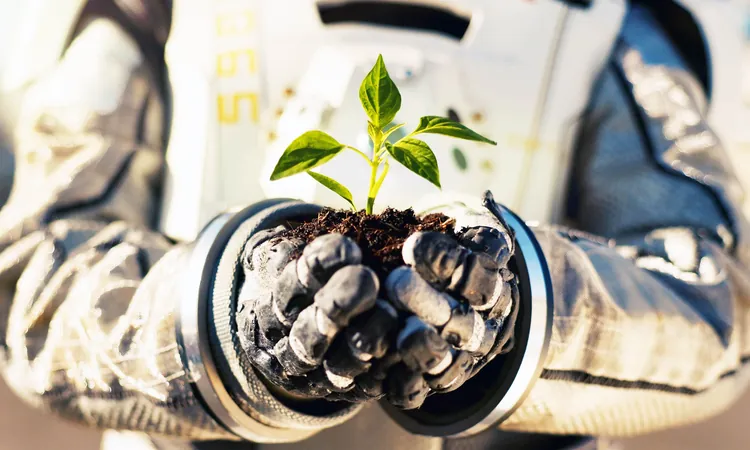
Space Lettuce: NASA's Bold Vision for Growing Nutritious Foods on Mars!
2025-01-12
Author: Sophie
NASA is pioneering innovative methods to provide astronauts with fresh and nutritious produce during upcoming missions to the Moon and Mars. While conventional sealed food packets have been the norm, they often lose flavor and essential nutrients over time—an issue that could significantly impact the health and morale of crews on long-duration space flights.
The cultivation of leafy greens and vegetables such as lettuce, peppers, radishes, and tomatoes aboard the International Space Station (ISS) is not just a theoretical concept; it’s a practical approach to maintain the wellbeing of astronauts. This initiative not only addresses food quality but also aims to enhance the mental health of crew members by offering them the joy of gardening and fresh food.
Plants: Crucial for Long-Term Space Exploration
Led by plant scientist Gioia Massa, NASA’s research team is investigating how various environmental factors—like microgravity, humidity levels, and light exposure—impact plant genetics, nutritional content, and overall yield. Their findings reveal that understanding the interplay between plants and their surrounding environment is key to growing food sustainably in space.
In addition to the plants themselves, researchers are also studying the bacteria that coexist with them. Understanding how these microorganisms react in space is pivotal for ensuring they remain safe and beneficial for human consumption.
The Challenges of Growing Crops in Microgravity
One significant experiment, known as Plant Habitat-07, assesses how lettuce adapts to different moisture levels in microgravity. Water is essential for plant health, yet finding the right balance is crucial; too much water can suffocate roots, while too little can lead to wilting. By simulating various moisture conditions in a specialized growth chamber, researchers are determining optimal strategies for future food production.
Enhancing Flavor and Nutrition in Space-Grown Vegetables
NASA’s Veg-04A and Veg-04B missions have provided valuable insights on how light quality and fertilization impacts the growth of crops like lettuce. Researchers discovered that altering LED light spectra or nutrients substantially influences both the appearance and flavor of the plants, leading to tailored growing techniques for vegetables like tomatoes. Feedback from astronauts regarding the taste and texture of these crops will inform future seed selections, ultimately offering a variety of fresh ingredients for interplanetary salads.
Further studies of Arabidopsis thaliana, a small flowering plant related to cabbage and mustard, illuminated how low-gravity environments affect gene expression and chemical regulation. Such insights could enable scientists to engineer plants with improved resilience to the unique challenges of space.
Understanding Plant Hormones in Space Conditions
NASA scientists are delving into the role of plant hormones, specifically auxins, which guide growth direction. Experimentation has shown that some species may exhibit altered auxin levels in microgravity, impacting their growth patterns. This research informs the design of growth chambers tailored to the specific needs of each plant variety.
Engineering Resilient Space Plants
Investigations into how roots and shoots adapt to microgravity have revealed that some plants develop weaker structures, while others adapt more easily. By identifying which plant varieties thrive or struggle in reduced gravity, NASA can refine growing conditions or select crops more likely to succeed.
The Path Forward: Sustainable Space Agriculture
Ongoing research to understand how changes in sterol levels affect flowering and development in microgravity represents another frontier in space agriculture. Managing these critical aspects will be vital for helping food crops grow reliably in the harsh conditions of space.
NASA's strides in space agriculture promise more than just tasty salad greens; they mark a monumental leap toward sustaining crews on extended missions. The initial results are encouraging, indicating that growing fresh food in orbit is not merely a dream but an achievable reality.
As innovative crop tests for flavor, nutrition, and preservation progress, humanity is on the brink of cultivating food far from Earth—an essential step as we aim for deeper space exploration. With dedicated experts like Gioia Massa driving this research, the future of agricultural practices in space looks incredibly promising for both astronaut nourishment and morale.



 Brasil (PT)
Brasil (PT)
 Canada (EN)
Canada (EN)
 Chile (ES)
Chile (ES)
 Česko (CS)
Česko (CS)
 대한민국 (KO)
대한민국 (KO)
 España (ES)
España (ES)
 France (FR)
France (FR)
 Hong Kong (EN)
Hong Kong (EN)
 Italia (IT)
Italia (IT)
 日本 (JA)
日本 (JA)
 Magyarország (HU)
Magyarország (HU)
 Norge (NO)
Norge (NO)
 Polska (PL)
Polska (PL)
 Schweiz (DE)
Schweiz (DE)
 Singapore (EN)
Singapore (EN)
 Sverige (SV)
Sverige (SV)
 Suomi (FI)
Suomi (FI)
 Türkiye (TR)
Türkiye (TR)
 الإمارات العربية المتحدة (AR)
الإمارات العربية المتحدة (AR)